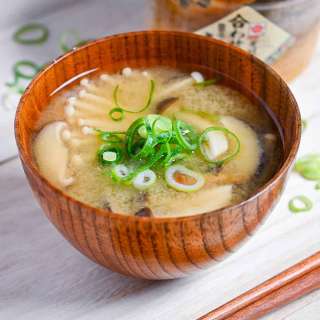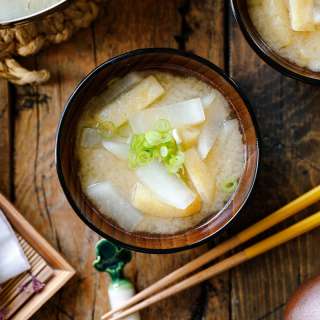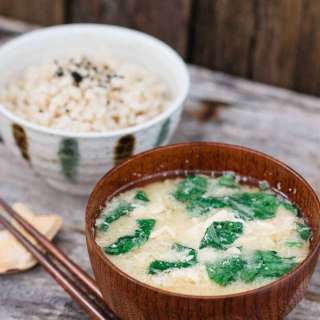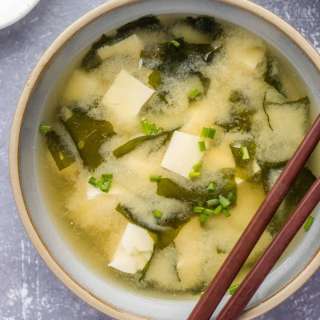
Tomato and Tofu Miso Soup
User Reviews
4.8
36 reviews
Excellent

Tomato and Tofu Miso Soup
Report
This Tomato and Tofu Miso Soup combines both comfort and refreshing flavors with just a few ingredients. Here, we pair sweet cherry tomatoes and silky tofu with a kombu dashi broth and finish it with savory miso paste. This vegan-friendly miso soup is lovely alongside any Japanese breakfast, lunch, or dinner.
Share:
Ingredients
For the Kombu Dashi
- 1 piece kombu (dried kelp) (⅓ oz, 10 g; 4 x 4 inches or 10 x 10 cm per piece)
- 4 cups water
For the Miso Soup
- 12 cherry tomatoes
- 7 oz soft/silken tofu (kinugoshi dofu) (½ typical 14-oz package)
- 4 Tbsp miso (I used Hikari Miso Kodawattemasu, Organic Red Koji Miso; typically, use 1 Tbsp miso for every 1 cup (240 ml) of dashi)
Instructions
- Gather all the ingredients.
To Make the Kombu Dashi
- Add 4 cups water and 1 piece kombu (dried kelp) to a medium saucepan. If you have time, soak the kombu in water for 30 minutes. NEVER wash kombu and do not remove the white substance—that’s umami! These days, it‘s pretty clean so just make sure there are no dirt particles.
- Set the heat to medium low and bring it to a boil SLOWLY over about 10 minutes. This allows you to extract as much umami from the kombu as possible. Right before the stock boils, remove the kombu and set it aside for another use. (If you leave the kombu, it gets slimy and yields a bitter taste.) Now, your Kombu Dashi is ready to use! Reserve the spent kombu and repurpose it; see the suggested recipes that follow at the end of the instructions.
To Prepare the Miso Soup
- Cut 7 oz soft/silken tofu (kinugoshi dofu) into ½-inch (1.3-cm) cubes.
- Add the tofu and 12 cherry tomatoes to the pot with the kombu dashi. Bring it to a gentle simmer until the ingredients are heated through.
- Once simmering, turn off the heat. Add 4 Tbsp miso using a fine-mesh miso strainer, which helps you dissolve the miso faster. After dissolving it, you may see rice koji (especially when it‘s koji miso) left in the strainer. You can either add it to the soup or discard it (personal preference). If you don‘t have a miso strainer, put 2 Tbsp of miso in a ladle, slowly add the dashi into the ladle, and stir with chopsticks to dissolve the miso completely before adding more miso. Take care not to break the tofu as you stir. Tip: You must taste the soup to determine if you need to add more miso. If you accidentally add too much miso, dilute the soup with dashi or water.
- Reheat the soup until it is just hot. NEVER BOIL miso soup because it loses nutrients, flavor, and aroma. Once it‘s hot, turn off the heat and serve immediately. Place on the right side of the table setting; you can read more about this in my Ichiju Sansai (One Soup Three Dishes) blog post.
To Store
- In general, it‘s best to consume all the miso soup right away because it will lose its aroma and taste as time passes. Let your miso soup cool to room temperature (up to 4 hours; any longer and it will spoil) and then refrigerate. Keep for up to 2 days in the refrigerator. If you want to make a big batch to store for later, it‘s best to refrigerate the soup without adding the miso. When ready to use, add the miso only for the portion you need. You can freeze miso soup for up to 2 weeks. However, you have to remove the tofu before freezing as the texture will change. If you have any leftover Kombu Dashi, you can store it in the refrigerator for up to 3–5 days and in the freezer for up to 2 weeks.
To Reheat the Soup
- Heat the miso soup in a pot over medium heat, but do not boil. Miso loses its nutrients, flavor, and aroma at high temperatures.
What To Do with the Spent Kombu?
- Save the spent kombu in an airtight container and store it in the refrigerator for a week or in the freezer for up to a month. You can combine it with the spent katsuobushi to make Homemade Furikake (Rice Seasoning).
- With the spent kombu, you can make Simmered Kombu (Kombu Tsukudani).
Notes
Nutrition Information
Show Details
Calories
60kcal
(3%)
Carbohydrates
7g
(2%)
Protein
4g
(8%)
Fat
2g
(3%)
Saturated Fat
0.3g
(2%)
Polyunsaturated Fat
1g
Monounsaturated Fat
0.4g
Sodium
459mg
(19%)
Potassium
233mg
(7%)
Fiber
1g
(4%)
Sugar
3g
(6%)
Vitamin A
260IU
(5%)
Vitamin C
12mg
(13%)
Calcium
29mg
(3%)
Iron
1mg
(6%)
Nutrition Facts
Serving: 4Serving
Amount Per Serving
Calories 60 kcal
% Daily Value*
| Calories | 60kcal | 3% |
| Carbohydrates | 7g | 2% |
| Protein | 4g | 8% |
| Fat | 2g | 3% |
| Saturated Fat | 0.3g | 2% |
| Polyunsaturated Fat | 1g | 6% |
| Monounsaturated Fat | 0.4g | 2% |
| Sodium | 459mg | 19% |
| Potassium | 233mg | 5% |
| Fiber | 1g | 4% |
| Sugar | 3g | 6% |
| Vitamin A | 260IU | 5% |
| Vitamin C | 12mg | 13% |
| Calcium | 29mg | 3% |
| Iron | 1mg | 6% |
* Percent Daily Values are based on a 2,000 calorie diet.
Genuine Reviews
User Reviews
Overall Rating
4.8
36 reviews
Excellent
Other Recipes















